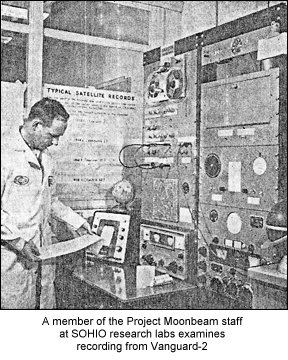 The
SOHIO station
The
SOHIO station The
SOHIO station
The
SOHIO stationThe satellite trackers at SOHIO used radio interferometer methods to track early U.S. satellites on 108 MHz (18). Two Yagi antennas were mounted on an east-west line. The director of the tracking station during the period 1958-1964 was Dr A.L. Jones. He was succeeded by Robert Thompson, who ran the station from 1964 until it ceased operations in May 1965. In 1963 Dr. A.L. Jones and his associates at the SOHIO Research Laboratory in Cleveland received the Aviation Week and Space Technology Laureates Award for achievements in operating a private satellite tracking station which provides so much valid data on Soviet space flights.
Mr. Thompson told Popular Mechanics (11) that the station tracked all of the Vostoks and Voskhods on shortwaves. From other reports we know that the SOHIO station picked up
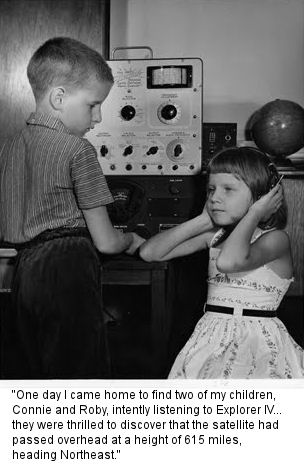
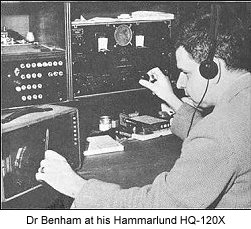 Dr. Thomas A(lonzo) Benham (1914-2006) at
Haverford
College in Pennsylvania was an early radio tracker in the U.S. (He
graduated
from Haverford in 1938). I first read about him in the
transcripts
of the U.S. House of Representatives hearing on Lunik-1 in May, 1959 (16)
where he described how he used radio equipment in his home to track the
Sputniks and early U.S. satellites. He used a Hammarlund HQ-120X
communications
receiver (0.54-31 MHz, manufacturing started in 1938) and a half-wave
dipole
antenna oriented north-south for 20 MHz and a frequency converter and
az-el
steerable antenna for 108 MHz, which was used for early U.S.
satellites.
He also described how he failed to pick up Luna-1 on shortwaves despite
being able to receive Sputnik-3 (at 0430 a.m. local time on 3 January
1958)
at the same time.
Dr. Thomas A(lonzo) Benham (1914-2006) at
Haverford
College in Pennsylvania was an early radio tracker in the U.S. (He
graduated
from Haverford in 1938). I first read about him in the
transcripts
of the U.S. House of Representatives hearing on Lunik-1 in May, 1959 (16)
where he described how he used radio equipment in his home to track the
Sputniks and early U.S. satellites. He used a Hammarlund HQ-120X
communications
receiver (0.54-31 MHz, manufacturing started in 1938) and a half-wave
dipole
antenna oriented north-south for 20 MHz and a frequency converter and
az-el
steerable antenna for 108 MHz, which was used for early U.S.
satellites.
He also described how he failed to pick up Luna-1 on shortwaves despite
being able to receive Sputnik-3 (at 0430 a.m. local time on 3 January
1958)
at the same time.
Professor Benham was a blind (since the age of two) teacher of physics with a keen interest in electronics during the early Sputnik era. He had his own recording company through which he published science recordings, TABEN Recordings (Thomas A BENham = TABEN). One of these records has survived to this day. The record "Voices of the Satellites" from 1958 contains recordings of Sputnik-1 and (purportedly) -2, Explorer-1,-2 and -3 as well as Vanguard-1. The recordings are narrated by Dr Benham and are quite fascinating to listen to (17). From the record we can learn that Dr Benham:
The picture on the right shows Professor Benham's children listening to signals from space.
George Caplan wrote (24): "When I was in junior high
school, I would ride my bicycle to Haverford College and help Professor Thomas
Benham. I was in his WWII radar trailer when he heard signals from one of the
satellites. I think its was Sputnik, but I might be wrong about that. I painted
the roof of that trailer, and I helped him with other things. (I sometimes
helped him use his table saw. Remember: He was blind!)"
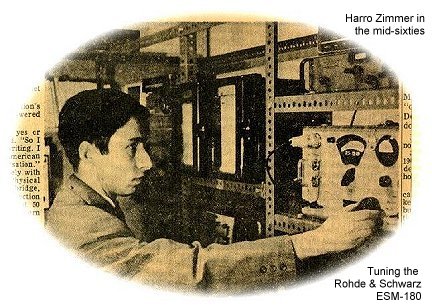 The
Wilhelm Foerster Observatory, Berlin
The
Wilhelm Foerster Observatory, BerlinThe WFO and its satellite tracking station was led by Harro Zimmer for more than 20 years. Mr Zimmer, later became a science broadcaster for RIAS-Berlin (Radio In American Sector) and Deutsche Welle. He also participated on the Viking mission in the Physical Properties Team (1976). The satellite tracking station co-operated with SAO, NORAD, USAF and other US agencies. WFO received element sets from NORAD through its AIG 7064 network (AIG=Address Indicating Group) via teletype until October 1977.
Very little was known at that time in international media about this observatory (I am sure German media gave the observatory reasonable coverage). Still, there is no comprehensive account of the observatory's activities. The only major article I know about is a newspaper article written by the news agency AP back in 1966. The picture on the right is taken from an old newspaper clipping with this article (14). In the article the 31-year old director of the operation, Harro Zimmer is interviewed. He explains that the observatory was able to pick up shortwave signals from Soviet space vehicles even when they sat on the launch pad (9). Many years later I contacted Mr Zimmer about this fascinating statement and he explained:
"After a quick look on my old papers here a short description of our observations. At first a remark: In the sixties and early seventies we had ..... no exact information about the lift off time. But the scheme in general in a retrospective interpretation: T - 5 minutes strong FSK signals on 19.995 MHz. T +/- 0 the transmission stops and was registered again T + 06-09 minutes later with intensity and frequency fluctuations." (10)The WFO seems to be the only non-government monitoring station in the West that actually heard voice from Vladimir Komarov when he piloted the ill-fated Soyuz-1.
The WFO was well-equipped for really serious space tracking work (See note about NOGOTON receiver, 12):

An examle of the kind of satellite tracking work that the WFO did is described by Harro Zimmer in a contribution to the list server SeeSat-L:
" ... for 1971-067C, #5382, LOADS 2 (Low Altitude Density Satellite) or better known as CANNON BALL 2. Around that time (1972) as I was the head of an US government supported satellite tracking station in Berlin we were engaged in this program. This heavy 65 cm spherical satellite (mass 364 kg) dipped at perigee deep in the atmosphere 100 +/- 05 km - was a difficult object for optical tracking. As I remembering correctly there were some observations from Russell Eberst. We had done mainly radio tracking. There was a radio beacon on board (136.53 MHz) [SG's comment: also on 136.86 MHz] ..."
Here is a description of the fate of the station that Christer Streiffert one of the last to work at the station sent me:
"The radio station at Vallby outside the town of Enköping near Stockholm was established in 1938 by the Royal Telegraph Administration (as it was them called). It was exclusively e receiving station. The site was manned around the clock and it was used for telegram traffic to other countries. Transmitters were located elsewhere in the country and remote controlled from Enköping. In addition monitoring activity intended to check compliance with radio regulations of all radio traffic in Sweden was located here. At the time this meant all frequencies below 30 MHz. In the 60's commercial aeronautical short-wave radio traffic also was handled by the station, i.e. telephone calls to Swedish airliners around the world were handled through the site. Gradually telegram traffic ceased as an operational activity and the aeronautical traffic became remotely controlled from Stockholm. The only activity left was the monitoring service, and in the 90's even that moved to Stockholm with the equipment being remotely controlled from Stockholm. "
The station was now managed by a new entity, the PTS, Sweden's equivalent of the FCC, created after the Telecommunications Administration had been converted into a corporation, and telecommunications in Sweden deregulated. The building has now (2002) been sold to a company that now runs a fruit winery in the old station building. The radio equipment is still there but the PTS now rents the space for the radio gear from the wine maker!
The pictures below were
taken
by myself when I drove out to the site, about 45 minutes from my hone,
on 7 August 2002.
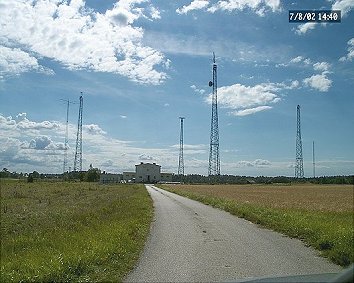 |
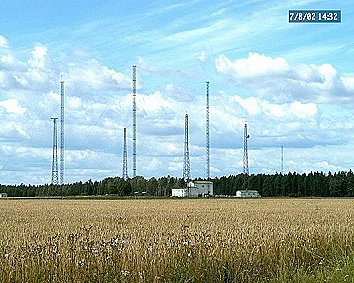 |
Here is an excerpt from Mikael Börjeson's web site describing how the Enköping station picked up Sputnik-1, that momentous day many years ago:
" ... September 1955 - With Härnösand Radio in progress to be closed, my parents and I move 500 km south, to Enköping and my father starts working as chief radio signal controller at Enköping Radio, in Vallby, 10 km outside the town of Enköping.
Oct. 1957 - Doing
his
normal duty as radio signal controller, in the night of Oct. 5, my
father
was randomly scanning around the short frequency bands when his
attention
was called by a weak signal with a strange fading pattern. After a few
minutes of experienced analysis he classified the the fading pattern as
a very unusual doppler-effect, probably caused by a "radio transmitter
orbiting around the globe" at high speed. The "Sputnik", launched by
the
Soviets 1957 Oct. 4, was discovered in West - by my father. Bringing
the
message out, political and military reactions were immediate,
especially
in
the United States. The Soviets percieved capability of "hitting
anywhere
from above" in fact became a main trigger for launching the United
States
military research program ARPA. The organizational foundation for the
Internet,
now being the main professional interest and occupation for me. ..."
| Sputnik-1 | Picked up on short-waves until 0300 UT October 25 (1) | |
| Sputnik-2 | ||
| Sputnik-3 | 15 May 1958,
2132 UT
16 May 1958, 0747-0751 UT 19 May 1958, 0520-0533, 0701-0716, 0844-0858, 1405-1414 UT. (4) |
|
| Sputnik-4 | 16 May 1960, a.m. 15-20 minutes per pass. (23) | |
| Explorer-4 | 28 July 1958, 1311-1314 UT, 1504-1509 UT. (2) | |
| Pioneer-1 | 11 October 1958, 0855-0901 UT, 1321-1335 UT, 1655 UT (3) | |
| Luna-1 | 3 Jan 59, 19.993 MHz,: 0024 UT, 0058-0118 (at least) UT, 0314- UT | |
| Sputnik-4 | Many observations of beacon on 19.995 MHz, See separate article. | |
| Sputnik-6 | Beacon picked up 1 Dec 1960. (5) until 1937 UT, the returned 2238 UT (6) | |
| Vostok-2 | Many observations of beacon on 19.995 MHz, See separate article. | |
| Vostok-3 and 4 | Plenty of voice picked up. See separate article. | |
| Vostok-5 and 6 | Beacon and voice picked up. See separate article. | |
| Voskhod-1 | Beacon picked up throughout 12 Oct 1964 until 1845 UT.(7) | |
| Voskhod-2 | Beacon and voice picked up. See separate article. | |
| China-1 | Beacon on 20.009 MHz picked up. (8) |
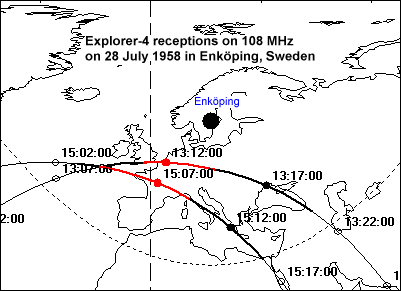 The
reception of Explorer-4 on 28 July 1958 was unusual, since most
receptions
had been made on short-waves. However, Explorer-4 was picked up on 108
MHz on two passes, the first at 20 degrees maximum elevation and the
second
at 13 degrees maximum elevation from the monitoring station. Explorer-4
had been launched from Cape Canaveral at 1500 UT on 26 July 1958 in to
an orbit between 257 km and 2213 km at an inclination of 50.2 degrees.
The map below shows the ground track for the satellite during
receptions
on 28 July 1958.
The
reception of Explorer-4 on 28 July 1958 was unusual, since most
receptions
had been made on short-waves. However, Explorer-4 was picked up on 108
MHz on two passes, the first at 20 degrees maximum elevation and the
second
at 13 degrees maximum elevation from the monitoring station. Explorer-4
had been launched from Cape Canaveral at 1500 UT on 26 July 1958 in to
an orbit between 257 km and 2213 km at an inclination of 50.2 degrees.
The map below shows the ground track for the satellite during
receptions
on 28 July 1958.